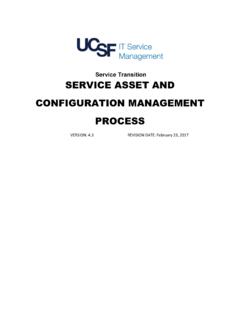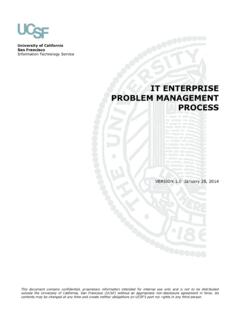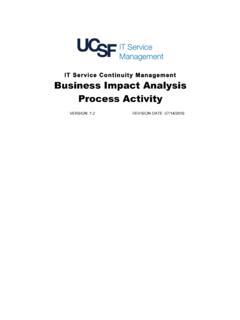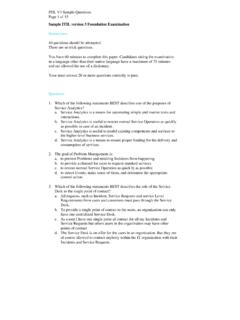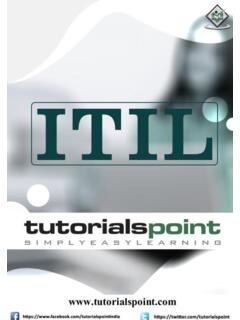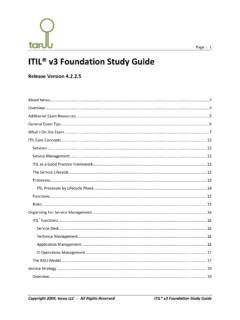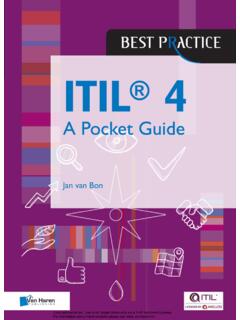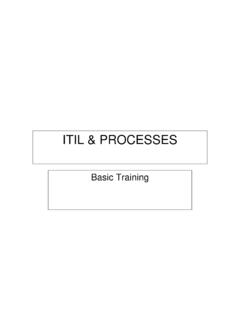Transcription of IT CHANGE MANAGEMENT Enterprise Change Management …
1 UCSF IT CHANGE MANAGEMENT Enterprise CHANGE MANAGEMENT Process version | 11/17/2020 Page i IT CHANGE MANAGEMENT Enterprise CHANGE MANAGEMENT Process version : REVISION DATE: 11/17/20 UCSF IT CHANGE MANAGEMENT Enterprise CHANGE MANAGEMENT Process version | 11/17/2020 Page ii Contents About this Process Document .. 1 Intended Audience .. 1 Assumptions .. 1 CHANGE MANAGEMENT .. 2 CHANGE MANAGEMENT Description .. 2 CHANGE MANAGEMENT Objectives .. 2 When to Submit a CHANGE Request.
2 2 When a CHANGE Request is Not 3 Types of Changes .. 3 Major Activities within CHANGE MANAGEMENT .. 4 UCSF CHANGE MANAGEMENT Organizational Hierarchy .. 6 Roles and Responsibilities .. 7 Operational Roles .. 7 Supporting Roles .. 9 Requesting a CHANGE .. 10 Submitters .. 10 Information Required to Create a CHANGE request .. 10 Review and Approval .. 11 Status and Status Transitions .. 14 Implementing the CHANGE .. 15 CHANGE the Status .. 15 Enter the Actual Start Time.
3 15 Document activity in the Work Log .. 15 Closing a CHANGE .. 16 Update the Result Codes .. 16 Work Log .. 16 Update the Configuration Item .. 16 Enter the Actual End Time .. 16 Post Implementation Review .. 16 Close the ticket .. 17 Limited CHANGE /Blackout & Heightened Alert-Critical Event Windows18 Limited CHANGE /Blackout /Heightened Alert-Critical Event Description 18 Obtaining Initial Approval .. 18 Submitting a Limited CHANGE /Blackout Window Request .. 18 Notification of Window.
4 19 UCSF IT CHANGE MANAGEMENT Enterprise CHANGE MANAGEMENT Process version | 11/17/2020 Page iii Submitting a CHANGE Request during a Window .. 19 Measuring Success .. 20 Reporting .. 21 Definitions .. 22 Process Advisory Team / Governance .. 23 Document version Control .. 24 Page 1 About this Process Document Intended Audience The document should be read by anyone working within the UCSF Enterprise CHANGE MANAGEMENT process. It should be used to maintain a standard set of practices so that anyone impacted by the practice (customers and providers) have common expectations.
5 Assumptions Only authorized individuals can perform CHANGE MANAGEMENT functions, as explicitly outlined in the proceeding CHANGE MANAGEMENT policy. In the absence of specific requirements thereunder, no undefined action may be taken without prior approval from the Service Transition Process Manager/ CHANGE Manager. Furthermore, no authorized or unauthorized individuals may intentionally or unintentionally circumvent the CHANGE policy whatsoever, without getting prior approval from the Service Transition Process Manager/ CHANGE Manager.
6 The CHANGE MANAGEMENT policy is a living document, which is continuously subject to revisions. At times the CHANGE MANAGEMENT policy might not be in sync with the functional automated control. Therefore MANAGEMENT will notify UCSF employees and HCL members of a CHANGE MANAGEMENT process; addition subtracted or modified in expressed writing via email. MANAGEMENT may reinforce the CHANGE in policy during CAB and ECAB meetings, as all CHANGE in policy notifications will be fully binding as to if they have been already inserted into the CHANGE policy.
7 Standard CHANGE Requests are only authorized to be used for the purpose they were approved. A single, common Enterprise CHANGE MANAGEMENT process is adopted and applied by each business (ITS, Medical Center, SOM). The CHANGE MANAGEMENT process assumes a tool-agnostic approach. The process was not designed around the capabilities of any specific tool set, but requires any tool used by UCSF to support the process. Appropriateness of the CHANGE was vetted before a CHANGE request is created.
8 Any CHANGE that is submitted in the CHANGE MANAGEMENT system is assumed to be an approved CHANGE by the business or application owner. The number and type of approvals required by workflow in the CHANGE MANAGEMENT system are dependent on the risk level of the CHANGE . The intent of the CHANGE MANAGEMENT system is to manage CHANGE . Separate itil processes such as Incident, Request, and Release and Deployment MANAGEMENT should be managed by systems that integrate with CHANGE MANAGEMENT . An implementer (assignee) cannot approve their own CHANGE .
9 The individual listed as the assignee on the CHANGE is expected to be the person actually implementing the CHANGE . In cases where a cross-team, collaborative effort is required to implement, the assignee is the person responsible for coordinating the implementation activities. A CHANGE request cannot go to Work In Progress (WIP) status before the Planned Start Date/Time. A CHANGE request is required for any CHANGE to production. The business may predefine instances where a CHANGE request is not required, but the overriding assumption is that any CHANGE to production requires a CHANGE request even if the implementer is certain that there is no risk and the CHANGE will not impact anything.
10 Perceived impact does not affect the requirement. Page 2 CHANGE MANAGEMENT CHANGE MANAGEMENT Description CHANGE MANAGEMENT is the process to manage the introduction of any enhancement, modification, update, installation, or removal of any hardware, software, interface, or database, or document that will impact the existing production environment. It ensures that only approved modifications to the environment are implemented. The CHANGE process should provide high visibility and open lines of communication between functional teams and the business.
